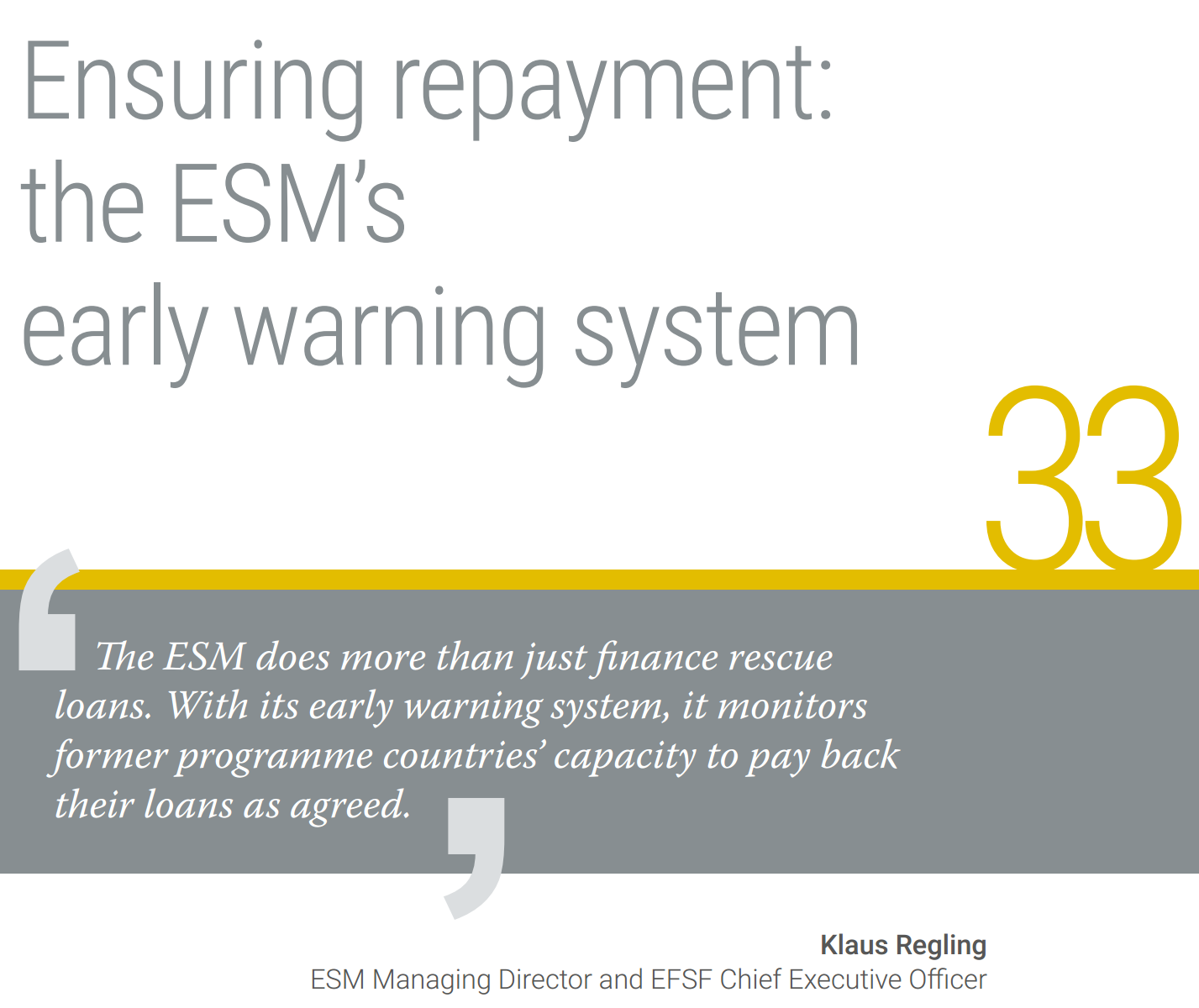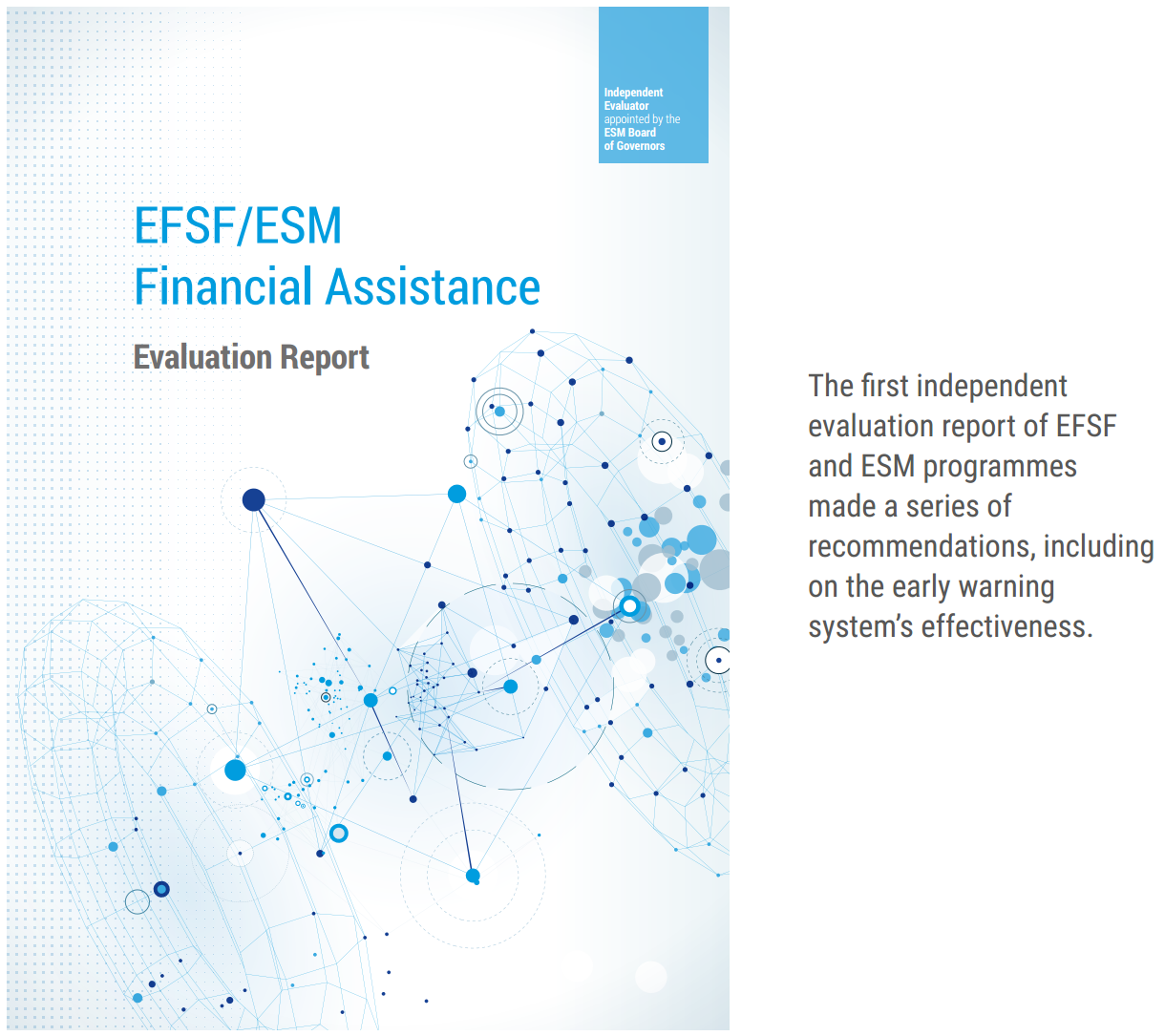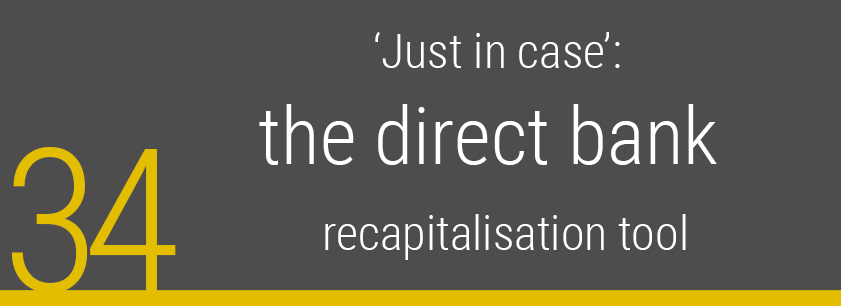33. Ensuring repayment: the ESM’s early warning system

Just as a private sector lender keeps tabs on the financial health of the borrower throughout the duration of the loan, the ESM needs to pay close attention to the balance sheets of the countries it assists. That is why governments mandated in the 2012 founding ESM Treaty that the fund ‘shall establish an appropriate warning system to ensure that it receives any repayments due by the ESM Member under the stability support in a timely manner’[1].
An early warning system procedure was approved by the ESM Board on 24 March 2014, after a 9 December 2013 Eurogroup decision to apply the system to EFSF loans as well. It requires the ESM to continuously track former programme countries’ cash flow, ability to borrow on the open market, medium- to long-term sustainability of public debt, and banking system risks. This monitoring complements the fiscal and debt sustainability analyses of the European Commission and ECB, with the ESM concentrating on the loan repayment outlook.
‘It’s like with a bank – when the bank considers giving you a mortgage it must assess the ability of the borrower to repay the loan,’ said Rojas, the ESM’s head of economic and market analysis. The only difference is that the ESM’s monitoring is ongoing. ‘This is basically our tool to make sure that countries repay.’
Under the EU Treaty, the Commission and national government representatives are responsible for post-programme surveillance of countries that receive aid. However, the ESM needs a monitoring role to keep watch over repayment prospects and make sure recipient countries can fulfil their responsibilities in a timely manner. After all, if a country were to miss a scheduled payment, it could call into question the ESM’s ability to act in a future crisis by affecting the firewall’s financial capacity and creditworthiness. The ESM must maintain its fiduciary duty to its Members and bondholders.
To flag any potential repayment problems, the ESM continuously tracks the due dates for interest, fees, and principal repayments at least 12 months in advance. At the same time, it looks a year ahead at each country’s budget and economic outlook, taking the Commission’s analysis into account. On a quarterly basis, former programme countries provide a cash flow overview that indicates how payments will be made.
‘Looking at the budget and economic outlook always means looking at policies, but it does not mean that we will in any sense negotiate policies,’ said ESM Managing Director Regling. ‘We only have to monitor and make sure no problems show up.’
The task will keep the fund busy long after most current employees have moved on: ESM guidelines require it to carry out repayment risk assessments under the early warning system until loans are fully repaid, which will be into 2070 in the case of Greece. In contrast, the Commission’s euro area post-programme surveillance of economic and fiscal policy ends after 75% of the loan is paid back.
If the ESM’s internal risk committee determines that there might be doubt on a timely repayment that could lead to a payment default to the ESM, it would then escalate the oversight process. In that event, the ESM would consult with the Commission and the ECB to assess the situation and its potential consequences in more depth. As a further escalation, the ESM would inform its Members, through the Board of Directors, of the repayment risk. Talks would take place immediately on a confidential basis.
To be sure, the ESM’s diversified funding strategy would help protect the firewall in the event of a delayed or missed payment. The rescue fund has flexible timing and instruments to ensure it always stays liquid.
A practical example of how the early warning system functions can be found in Ireland. In an important sense, the EFSF’s first client has been an unqualified success story, showing that a country can turn its fortunes around quickly if it commits to reforming its economy.
At the same time, Ireland can’t let down its vigilance. The post-programme assessment[2], published in February 2018, found downside risks to the economy, particularly due to the uncertain effect of the UK’s decision to pull out of the EU. While welcoming the near-elimination of the deficit and early repayment of bilateral loans from Denmark, Sweden, and the IMF, the report urged the Irish authorities to work harder to boost the ‘shock resilience’ of public finances. Overall, however, it concluded that, thanks to improved debt sustainability and other factors, the risks for Ireland’s capacity to service its EFSF and ESM debt ‘remain low’.
That sort of intelligence isn’t obtainable only by sifting through economic data back in Luxembourg. To gain a nuanced, first-hand impression of the state of a country’s economy and government finances, the ESM needs experts who can be on the ground.
As with many ESM tools, the early warning system has been adapted and updated as the firewall gained experience. Originally, due diligence analyses were staggered according to each country’s repayment schedule. But varying dates for repayment led some countries to be examined more often than others. Portugal’s repayments were spread over the year, leading to frequent assessments, whereas Spain made only one payment a year, in December. ‘So, in the case of Spain, we were monitoring the repayment capability less often,’ Rojas said. ‘This is risky because, if something happens outside of this time period, then we could have a problem.’ As a result, the new policy provides for quarterly monitoring, regardless of payment due dates.
There was a similar logic to lengthening the time horizon of the early warning system assessment to a full 12 months from the five that were initially specified. It is thus no longer theoretically possible for a country to meet its December payment obligations and then run into trouble a few months later.
‘We didn’t want to take the risk of having a ripple after a repayment,’ Rojas said. ‘Even if a particular country doesn’t have to repay to us, the fact that a particular country defaults on some loans to other institutions, for instance, could trigger a default clause for our loans.’
Data-reporting standards also have been refined. At first, countries provided cash flow data in a variety of formats, sometimes lacking sufficient detail, making it hard for the ESM to obtain the complete picture. Now all use the same template. ‘One time, we got the projections in such a way that the information was almost completely irrelevant,’ Rojas said. ‘A goal of the new guidelines was also to send a message of, look, for something as fundamental as this, we must all take a standard professional approach.’
The changes were approved by the ESM Board of Directors on 18 March 2016.
The ESM worked closely with each country’s debt management office to identify which numbers it would need to see. Given the role of bank recapitalisation in aid programmes, the ESM also needed access to more banking data. The exposure of banks to sovereigns and vice versa means that troubles in the financial sector can have repercussions for national budgets. At first, some countries worried that their banking data could fall into the wrong hands, especially since they were still getting used to watching the ECB’s Single Supervisory Mechanism pore over the sector’s books, but the ESM was able to put safeguards in place to reassure them.
‘Banking issues are usually very delicate,’ Rojas said. ‘We were able to overcome these concerns by including in the new guidelines statements saying that the projections a country sends us can only be used for the risk assessment activities of the ESM, and that only those people involved in risk assessment activities can access the data.’

As much as possible, the ESM uses publicly available data. Only when a specific risk is identified does the ESM contact supervisors to drill deeper into the figures.
How will the early warning system evolve from here? A 2017 evaluation report[3], commissioned by the ESM Board of Governors, recommended a review of its effectiveness, noting that its ‘scope and enforcement power is limited’.
‘The EWS relies on moral persuasion, peer pressure, and the powers of other institutions to achieve its purpose,’ the report found.
In terms of its mission to monitor programme countries’ ability to repay, the report said that the early warning system was ‘adequate’, but questioned what would happen if risks arose. It suggested that the system could do little to prevent a rollback or even reversal of reforms. Furthermore, it noted that the early warning system is ‘limited to programme countries, which does not allow it to capture systemic risks.’ One way to prevent future crises could be to expand the early warning system monitoring process beyond the countries that are paying back aid. This would involve changing the ESM’s remit, and it would make it easier to combat the next crisis if problem spots are identified sooner.
The euro area is in the midst of shaping the future of its institutions. Towards the end of 2018, Member States agreed to broaden the mandate of the ESM beyond aid programmes while respecting the mandate of the European Commission related to surveillance and economic policy coordination.
Continue reading
[1] Treaty Establishing the European Stability Mechanism, 2 February 2012. https://www.esm.europa.eu/sites/default/files/20150203_-_esm_treaty_-_en.pdf
[2] European Commission (2018), ‘Post-programme surveillance report: Ireland, autumn 2017’, European Economy Institutional Paper 074, Publications Office, Luxembourg, February 2018. https://ec.europa.eu/info/sites/info/files/economy-finance/ip074_en.pdf
[3] Tumpel-Gugerell, G. (2017), EFSF/ESM financial assistance: Evaluation report, Publications Office, Luxembourg. https://www.esm.europa.eu/sites/default/files/ti_pubpdf_dw0616055enn_pdfweb_20170607111409_1.pdf


